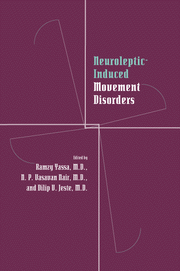Book contents
- Frontmatter
- Contents
- Contributors
- Preface
- Part I Historical perspective
- Part II Clinical aspects of tardive dyskinesia
- Part III Mechanisms underlying tardive dyskinesia
- Part IV Measurement of tardive dyskinesia
- Part V Tardive dyskinesia in different populations
- 19 Cultural aspects of tardive dyskinesia in Asia
- 20 Tardive dyskinesia in North America and the Middle East
- 21 Tardive dyskinesia in Europe
- 22 Role of ethnicity in the development of tardive dyskinesia
- 23 Tardive dyskinesia in children and adolescents
- Part VI Other neuroleptic-induced movement disorders
- Part VII Treatment of tardive dyskinesia
- Index
19 - Cultural aspects of tardive dyskinesia in Asia
from Part V - Tardive dyskinesia in different populations
Published online by Cambridge University Press: 09 October 2009
- Frontmatter
- Contents
- Contributors
- Preface
- Part I Historical perspective
- Part II Clinical aspects of tardive dyskinesia
- Part III Mechanisms underlying tardive dyskinesia
- Part IV Measurement of tardive dyskinesia
- Part V Tardive dyskinesia in different populations
- 19 Cultural aspects of tardive dyskinesia in Asia
- 20 Tardive dyskinesia in North America and the Middle East
- 21 Tardive dyskinesia in Europe
- 22 Role of ethnicity in the development of tardive dyskinesia
- 23 Tardive dyskinesia in children and adolescents
- Part VI Other neuroleptic-induced movement disorders
- Part VII Treatment of tardive dyskinesia
- Index
Summary
Various neuroleptics have been widely used for treatment of schizophrenia in Asian countries, but long-term administration of these antipsychotic agents involves the risk of inducing complications, such as tardive dyskinesia. Sigwald, Bouttier, and Raymondeaud (1959) first described tardive dyskinesia in French hospitals, and Uhrbrand and Faurbye (1960) published a Danish epidemiologic study a year later.
In Asia, Japanese psychiatrists (Miyamoto et al., 1966) first described “mogue-mogue movement” as abnormal involuntary movements of the orofacial region in psychiatric patients; they concluded, however, that the abnormal movements were not related to administration of neuroleptics. That mogue-mogue movement was not dealt with again until the 1970s, when it was identified with tardive dyskinesia in a review by Kazamatsuri (1971) – a review that marked the beginning of public concern about tardive dyskinesia in Japan. In India, Pandurangi, Ananth, and Channabasavanna (1978) were the first to investigate the prevalence of tardive dyskinesia in mental hospitals. In China, an accurate epidemiologic study was carried out by a Chinese-American team (Ko et al., 1989). In Taiwan and Singapore, it was Lin and Chen (1980) and Kua, Ang, and Siew (1982), respectively, who first investigated tardive dyskinesia in chronic schizophrenia inpatients.
This chapter reviews the epidemiologic studies of tardive dyskinesia in Asia; it also discusses the clinical characteristics of tardive dyskinesia in Asian patients.
- Type
- Chapter
- Information
- Neuroleptic-induced Movement DisordersA Comprehensive Survey, pp. 259 - 266Publisher: Cambridge University PressPrint publication year: 1996



